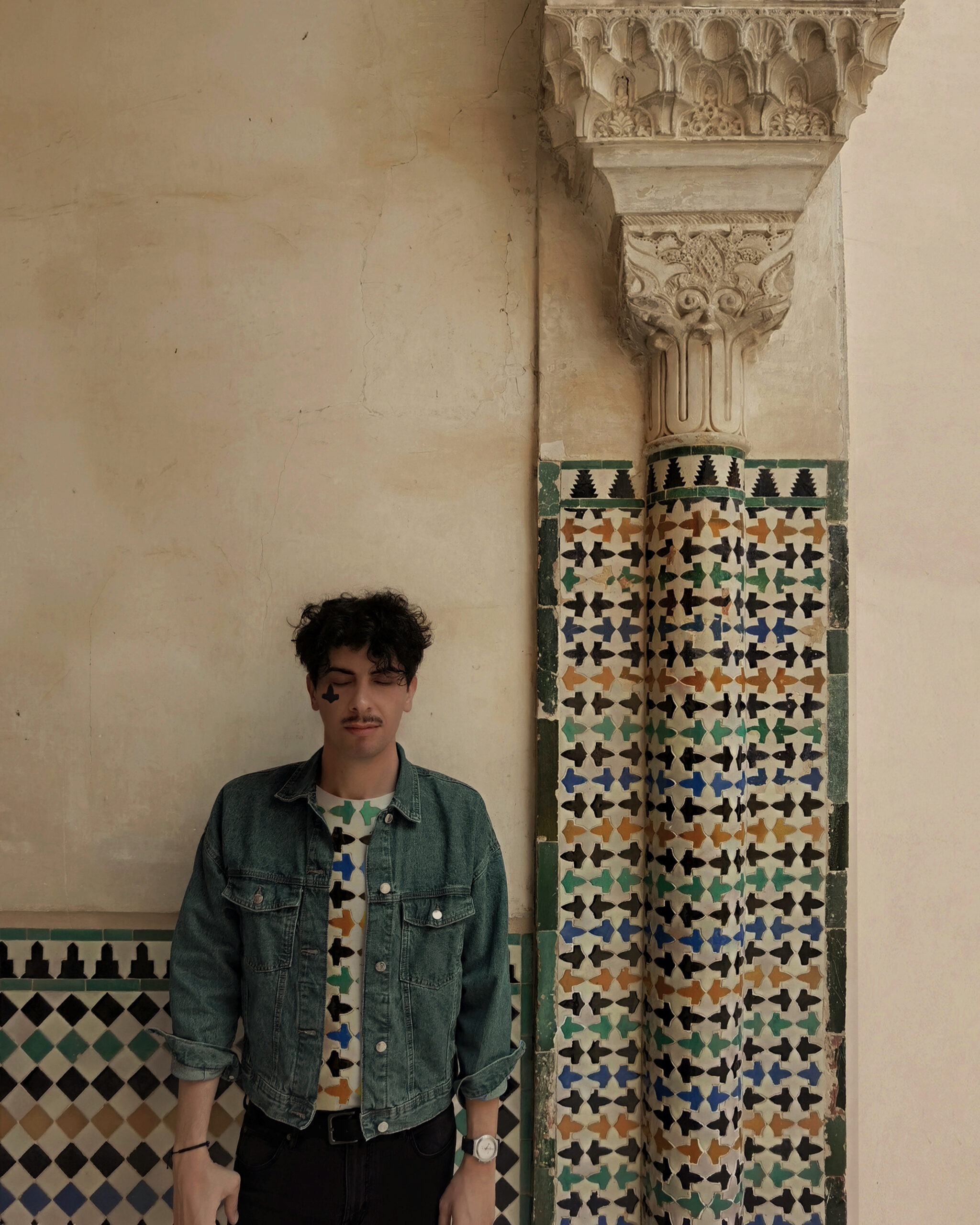If you want to travel back to the ancient days of Al-Andalus, the Muslim-ruled area of the Iberian Peninsula, I have found your guide. Discovering his art is immersing yourself in another dimension, where you can almost feel and smell the wonders and flavours of the East. From Granada, interview with an artist who skillfully blends past and present.
Hi Eduardo! How would you describe yourself at the 3rd person?
EduArtGranada: Eduardo Gorlat, artistically known as EduArtGranada, is a multidisciplinary artist. His father, a lover of painting and drawing, introduced him to the world of art from a very young age. After completing his university studies in Political Science and Sociology, he worked in cultural management before deciding to be a full-time artist. He is mainly dedicated to illustration and design although he likes to create at all levels, since he does not believe in keeping arts separate: he likes photography, cultural dissemination and participating and consulting in different projects. Its main inspirations are the Alhambra and Granada, al-Andalus as well as the Arab and Persian cultures.
You were born in Granada and grew up between Switzerland and France. How did the feeling of being from Andalusia remain in you and what does it mean?

The artist and La Alhambra
E: Being born in Andalusia and specifically in Granada has undoubtedly marked my life. In my earliest childhood, my family and I went to live in Switzerland and later in France for my father’s job. It made me have a stronger connection with my own identity, it opened my spirit and marked my education, allowing me to value my own culture.
I identify with the history of my land. Being from Granada/Andalusia is being from everywhere. All cultures have left their mark and the sediments that make it a rich and special terrain. Our historical-cultural particularities have turned Andalusia into a place where every human being can identify for any small reason and feel they belong. In particular, the beauty of Granada lies in the fact that it lives somewhere between nostalgia and joy, between a past that never goes away and a mysterious present. My love relationship with Granada seems to have no end, in fact I integrated it into my stage name forever, as if it were my last name.
Travel: you visited and lived in various countries in Africa, the East and Europe – which now allows you to depict and mix Mediterranean, Arab and Persian cultures in your work. What is the intention/message behind your art?
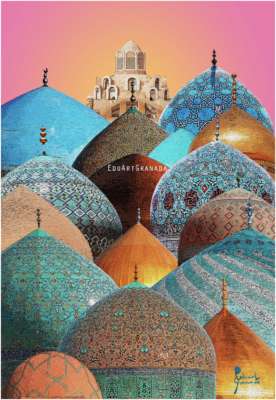
Domes of Iran
E: I have had the great privilege of being able to travel from a very early age. The journey to other countries and cultures must be accompanied in parallel by a conscious and internal one. Visiting another country is not simply taking a suitcase and a plane. Traveling is understanding and recognising: the surprise of the traveler is to discover that you are not alone in the world or that your land is the best.
My weakness for traveling to countries in North Africa and East & Central Asia is undoubtedly determined by being born in Granada. My city, which is the East in the West, has made me feel attracted to these types of cultures that are geographically distant but very close to my soul. The Mediterranean is the best example that borders are not as important as shores are. Through my travels and above all, through my art, I aim to break down borders, both for my fellow citizens and people from abroad. I am Andalusian, therefore my relationship with Mediterranean cultures, and by extension Arabs and Persians, is unbreakable. I have felt at home in many very distant countries and at the same time, from my home I feel that proximity and inspiration from the East. Therein lies the magic of the external and internal journey.
My art aims to represent those shores that I talked about before: shores bathed by many waters and where anyone who wants can disembark. Putting boundaries to an art is to not understand it. There is nothing pure enough to be unique. The influences and that permeability are what produce the best art, the one that is universal and the one that everyone understands.
Fusion of disciplines: you started with watercolor and oil, and then took on photography, graphic design and digital illustration. Is that what you call “visual poetry”?
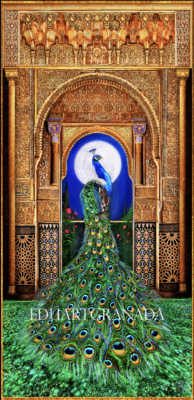
Sultan del Generalife
E: From little I taught myself to paint and benefited from the advice of my father, who brought made art accessible to me through exhibitions, museums, and music. I think it is more important to immerse yourself in art from the essence rather than through the technique. I started painting in pastel, watercolour and gouache, later acrylic and finally oil. I learned the techniques afterwards. Knowing them allows you to respect pictorial tradition.
Over time, I got interested in photography and studied graphic design, but I also realised that I don’t like to pigeonhole myself into just one thing. From there I invented and interconnected techniques in a mix that has resulted in my personal style. I do not have a precise technique, sometimes it is only manual, in others it is combined with digital illustration or even photography. I want to specify that I never use artificial intelligence, only “natural” intelligence. I think it is not for me, at least as it is conceived for now, as it lacks something essential: the inner fire of creation that only the artist can feel…
I like to define my style as “visual poetry.” I think that in one way or another, poetry is behind everything. Or so I want to believe. I like writing and of course reading, especially poetry, and I also try to bring it to my artistic and more plastic expression. The images and works that I create are always based on something poetic. My goal in art is that looking at some of my works becomes something similar to reading a verse, where each detail can be like a rhyme… My goal is to know that every work can be the inspiration for another, the consolation for those who need it, the gift of a shared nostalgia and giving shelter and support to all the love that fits within a glance.
I cannot interview you without mentioning the Alhambra, omnipresent in your work. When did your passion for it, for Andalusian art, begin? Do you remember the moment it happened for the first time?
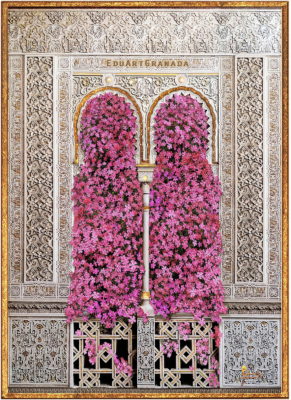
Ataurique en flor
E: Talking about Granada is talking about the Alhambra, and pronouncing the word Alhambra is talking about my greatest source of inspiration. Quite an emotional syllogism. I don’t remember my first visit to the Nasrid monument, but it was at a very young age. Every time I came to Granada on vacation, I wanted to visit it. There was something about it that fascinated my child’s eye. I couldn’t quite understand why, but I felt very attracted to that space so different from all the others. That spell and love for the Alhambra is something that I cannot explain, I don’t remember since when but I have always known that it is there. It grows stronger every day.
I visit it very often, I follow all the courses and trainings on all Alhambra- and Nasrid-related themes, I make dedicated visits to specific spaces. It is a kind of necessity that fuels a large percentage of my creativity and artistic inspiration. The Alhambra is more than a monument, more than a city. It is the paradigm of beauty, a riot of the senses. The sound of water, light, nature and architecture live in perfect harmony in the Alhambra. Through my work on the Alhambra, I try to search for the inner voice and the internal stories that continue to live in it, bringing that Andalusian Granada back to life, without pressure or idealisations.
In 2022, I organised an exhibition at the Fundación Euroárabe called “Kalam Gharnata” (Arabic for “The Words of Granada”) where I wanted to bear witness to all that hidden and poetic language through my visual works about the Nasrid Alhambra and Granada. A collection of more than 70 illustrations shows all the visual poetry of my city. This project continues to expand, and I also intend to turn it into a book and a traveling exhibition wherever “those words want to be seen and heard”.
My training on al-Andalus began early on, through my interest and reading, but it grew stronger as a result of starting to work in cultural management, in a foundation called “El Legado Andalusí”, which aims to promote al-Andalus’ heritage through exhibitions, publications and in the tourism and cultural sector.
In 2020, I joined an organisation supported by the Ministry of Culture of Spain, called “Continuadores del arte vivo andalusí” that safeguards and brings together artists, artisans and many other specialists and experts which carry and reflect the Andalusian identity, heritage and tradition through their work. This network tries to showcase how that art and tradition is still alive today. They allowed me to promote and exhibit my work at the 2020/21 Dubai World Expo.
I feel proud to be an ambassador of the legacy left by al-Andalus, through my creative and informative work. On the other hand, I feel the urgent need to continue showing openly and unashamedly that culturally special and rich place from which we come.
As a French person, your series on “The Little Prince” adapted to different cultures to celebrate its 80 years caught my attention. How did this desire to represent this mythical character come about?
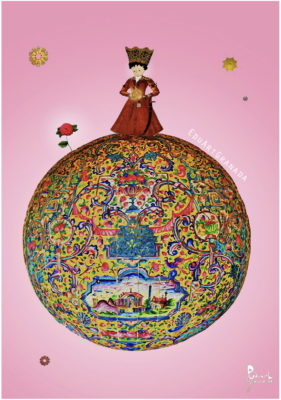
Le Petit Prince Qajar
E: The Little Prince is a reference in universal literature and as a person who has lived in France, I feel it as something very personal. Since I read it for the first time as a kid, I identified with that child who travels through different planets searching for truth and the nature of feelings. Its magic lies in the fact that it can be read by both children and adults: to the child it reveals what maturity will be like, and to the adult it conveys the simplicity and innocence that we are losing little by little.
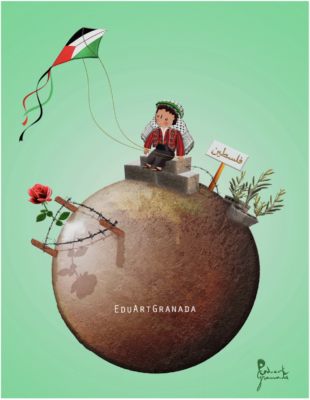
Le Petit Prince de Palestine
Through my series of “Little Princes of the East”, I wanted to give it a more cultural dimension according to my style and references. A tribute under my personal seal, which would be to orientalise those other worlds of the Little Prince. Adapting, out of respect for that child that travels inside me and that goes from west to east, in addition to wanting to mention countries like Iran, Turkey, India or my own al-Andalus, which I admire so much. We are all looking for a rose, no matter the garden where it grows.
I also want us to look at your work on Cairo (2022). What inspired you?

Cairo Solar, Cairo lunar
E: I have been very fortunate to visit Cairo on several occasions, sometimes for business and sometimes for pleasure. I have great memories every time I think about that magnificent city. Many people are impressed by its grandeur and the certain traffic chaos of the hustle and bustle of its streets… However, once we have surpassed that stage, I have always considered that it is a city with a strength like few others. It has always been important. Everything is big. The city of a thousand minarets, of a thousand domes. I have felt exhausted and very small in front of its imposing architecture, and that is precisely what has made me try to represent it on numerous occasions. There was a time when I only made works about Cairo, I was obsessed by its volumes, its heights… Perhaps the most notable work is my work “Cairo Solar, Cairo lunar” which you’re talking about. It is a work that aims to highlight its greatness, monumentality and above all, its duality. It was illustrated while listening to Oum Kalthoum uninterruptedly. That work is undoubtedly the result of surrender and admiration. In Arabic, Al-Qahirah (Cairo) means “The Victorious” and therefore captures that victory both night and day through time.
You recently released your podcast about Federico García Lorca (@LovingLorca) – tell me about it!
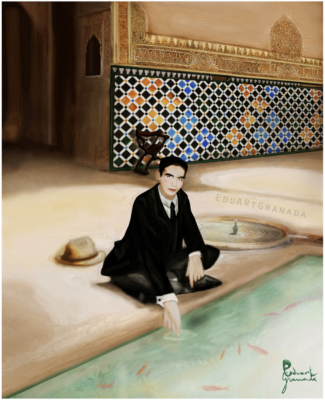
Retrato de Lorca
E: In addition to the Alhambra, Granada and the East, I have a great role model, which is the beloved and admired Granada poet Federico García Lorca. I have realised that the symbols present in my references are the same, they share the same essence. Lorca’s work has determined my identity and has given me solace through reading it. Its poetic, open character, always oscillating between beauty and drama are for me the synthesis of what life is. I have made numerous pictorial works about Lorca, such as portraits of the poet and others inspired by his verses.
For a few months now, I have created, together with Víctor Arlegui Soria, an actor, poet and playwright friend, our podcast Loving Lorca, which aims, in a simple and intimate way, to present texts by Federico Garcia Lorca. Through dramatised readings, accompanied by illustrations and other effects, it shows lesser-known facets of the poet. Our mission is to present, without major debates or explanations, its true essence, which makes it immortal and universal. Our podcast Loving Lorca can be heard Spotify and Ivoox, and little by little we will give it new directions.
I came across an article that said that your style “fits into a positive and inclusive orientalism” – what does it mean to you?
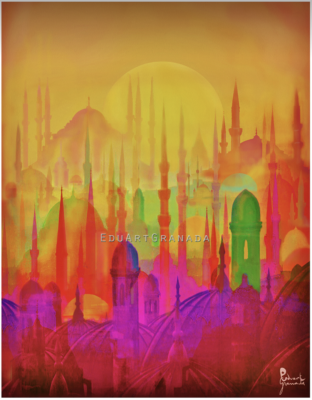
Istanbul
E: From the West, it is very difficult to express what the East is. There is not a single East, just as there is not a single West. It is a somewhat risky game, which has not always gone well. The orientalism that emerged in the 19th century was full of clichés, prejudices and built on interpretations. Westerners have built an image tailored to their needs and whims of what the East is, and that has caused a lot of harm and conflict in the relationships between them. Edward Said, in his book “Orientalism”, was the first to highlight this phenomenon. It is true that the East has a special attraction that ends up fascinating us, it often plays with fantasy and for me as an artist it is an attraction that I constantly fall into. Of course, fantasies must be built on realities that do not disturb or damage the truth behind them.
That’s what I call “positive orientalism”: recognising things in others as their own without violating their cultural rigour. I also have to say that the East has often taken advantage of this orientalism to reinvent itself and sell itself to the world. This also happens in Granada and my mission is to show this Eastern West with a background that is real and faithfully rigorous. It is not worth showing an orient like that of Walt Disney’s Aladdin or the Arabian Nights. The East can be just as fascinating in its true features without needing to be distorted or exaggerated. That is the positive orientalism that I try to show in my works.
There is something very interesting and inspiring in your journey: getting to listen to your inner voice and following your own path – like in The Alchemist by Paolo Coelho. How did you manage to do it?
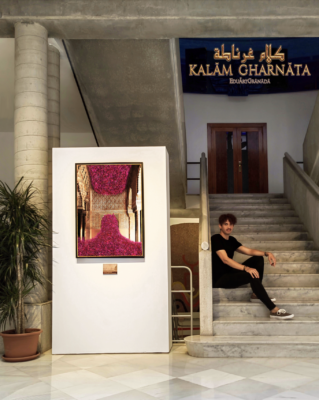
The artist with “Alud Nazarí”
E: The artist’s path is not easy. Living from the expression of your inspiration and your feelings takes courage in a world marked by competition, the quest for success and money. Many times, people believe that art is just a hobby and cannot be a livelihood. For me, art is a way of life. Everything leads me to it. I understood that message several years ago, when I knew that my life had to be sincere and tend towards it. I studied political science and later worked in cultural management, but I felt that it was not my path. After a long internal debate, I made the decision to dedicate myself full time to it. Fortunately I have always had the support of my family since the beginning and little by little I have become convinced of it. Nobody gives you the title of artist, like you can be given the title of doctor or lawyer… The title of artist must be self-given, since an artist is someone who produces art. Free of complexes. Success is something else, it cannot be sought, only through constant work and preparation, like any job.
In our society it is necessary to be brave and at least bet on what makes us happy. It has been shown that art can save and is eternal and special in every civilisation… Is there anything more beautiful than dedicating yourself to saving yourself and saving the world in that way?
Do you want to share a final message with our readers?
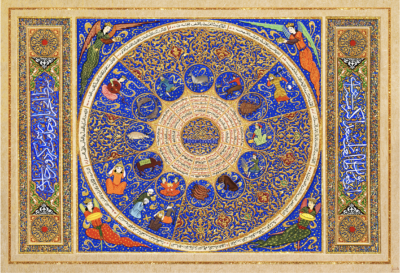
Iskandar Sultan Horoscope. EduArtGranada reinterpretation
E: I would like to thank you for the opportunity to express myself and that after these few words you have been able to get to know me a little better. I have tried to show what my work, my inspirations and my references are. They are mine, with no other intention than to demonstrate that we must all have them, whatever they are: the commitment to the search and defense of our roots without losing the vision of an open and connected world. Understanding and loving our differences makes us equal and at the same time unique.
In addition, I would like to invite you to follow my inspirational day-to-day life and my work, if you liked it, through my social networks: @EduArtGranada and say that my works are for sale and I am open to listening to proposals that open new ideas for me, creative paths of inspiration. I believe a lot in connection through art, that language that we all know how to read without needing to be explained.
From Granada, the city of the Alhambra, Eastern West, I send you a very affectionate greeting and much inspiration. Thank you!
This interview has been edited for length and clarity. Cover picture: The artist in La Alhambra © EduArtGranada All pictures © EduArtGranada

